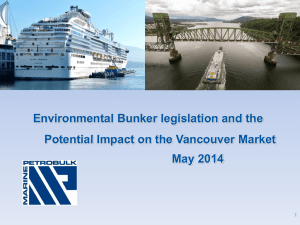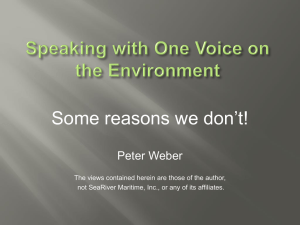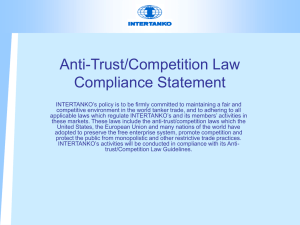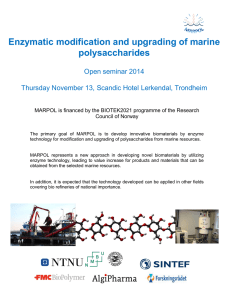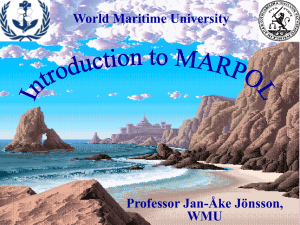REGULATIONS/STANDARDS IMO MARPOL ANNEX VI
advertisement
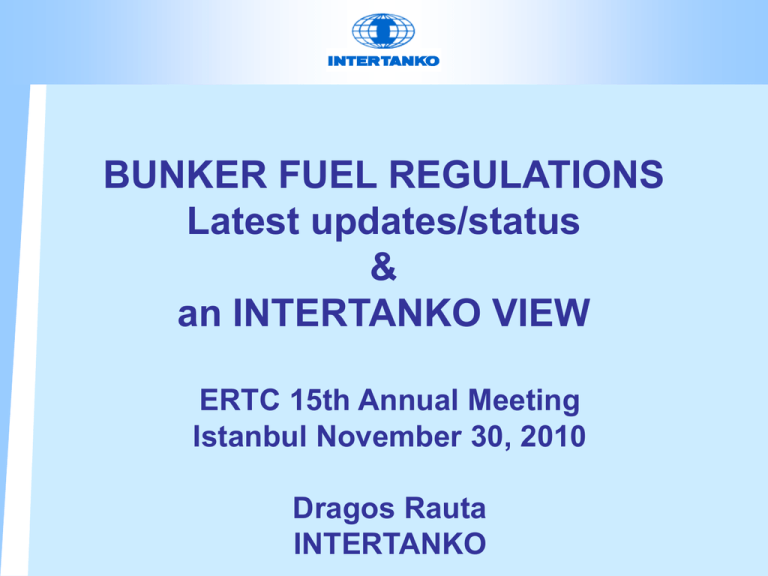
BUNKER FUEL REGULATIONS Latest updates/status & an INTERTANKO VIEW ERTC 15th Annual Meeting Istanbul November 30, 2010 Dragos Rauta INTERTANKO INTERTANKO International Association of Independent Tanker Owners A non-governmental organization established in Oslo in 1970 to represent the interests of independent tanker operators at international, regional, national and local levels 260 Members 45 countries 3,100 tankers 250 million dwt 330 Associate Members Spokesman – information service - meeting place 23 Secretariat Oslo, London, Washington & Singapore 14 Committees and 5 Regional Panels Bunker Sub-Committee (tanker operatos, IBIA, test labs) REGULATIONS/STANDARDS • IMO – MARPOL ANNEX VI – GREENHOUSE GAS EMISSIONS (GHG) – SOLAS • REGIONAL – EU SULPHUR DIRECTIVE – CALIFORNIA AIR RESOURCES BOARD • ISO 8217:2010 IMO - MARPOL ANNEX VI • • • • Limits SOx emissions Includes PM (particulate maters) Compliance through sulphur content in fuels Alternative methodologies accepted as Equivalent Measures • Addresses marine fuel oil quality • Recommends no measures on ships if supply is not adequate • Guidelines to asses compliance if BDN data is challenged by PSC (or by lab test results) SULPHUR LIMITS IMO APPLICATION DATES • IMO Global S limit (by weight) – current – 1 July 2012 – 1 January 2020/(2025) 4.5% 3.5% 0.5% • IMO ECA S limits (by weight): – up to 1 July 2010 – 1 July 2010 – 1 July 2015 1.5% 1.0% 0.1% MARPOL ANNEX VI ECAs 62˚N 4˚W ECA 1 ECA 2 57˚44.8’ N 5˚W 48˚30’N MARPOL ANNEX VI ECAs Entry into force 1 August 2012 ECA 3 200 nm 200 nm Will Mexico join ? Caribs? REGIONAL REGULATIONS ON BUNKERS • EU SULPHUR DIRECTIVE – as MARPOL Annex VI sulphur provisions – additional provision: use of 0.10% sulphur content fuel (or alternative) when ships ”at berth” (1 Janaury 2010) – MGO/MDO on the EU market should have < 0.1% S content (1 January 2010) • CALIFORNIA AIR RESOURCE BOARD (CARB) – use of marine distillates within 24nm off shore – sulphur content in the marine distillates: • current – MDO max. 0.50%; MGO max. 1.50% • after 1 January 2012 - MDO/MGO max. 0.10% CARB MGO 2.5 MDO/MGO MGO MDO 0.5 EU 3 2 1.5 LSFO SULPHUR CAP (%) APPLICATION DATES & S Cap 4.5 1 IMO/Global HFO 4 IMO/ECA 3.5 0 01 01 01 01 01 01 01 01 nu Ja nu Ja nu Ja nu Ja nu Ja nu Ja nu Ja nu Ja y ar y ar y ar y ar y ar y ar y ar y ar 24 20 22 20 20 20 18 20 16 20 14 20 12 20 10 20 MARPOL ANNEX VI Regulation 4 – Equivalent measures • An Administration may allow any fitting, material, appliance or apparatus to be fitted in a ship or other procedures, alternative fuel oils, or compliance methods used as an alternative to that required by this Annex if such methods are at least as effective in terms of emissions reductions as that required by this Annex • This means the Administration (and not the ship) have to acknowledge that: – technologies have equivalent efficiency in terms of SOx, PM and NOx. – they do not harm the environment – they operate within the requirements of the IMO guidelines MARPOL ANNEX VI FUEL OIL AVAILABILITY • IMO set up a correspondence group to consider establishing a methodology to determine the availability of fuel to comply with the global sulphur limit in 2020 • Supply/demand models • Consider – – – – – current experience with supply new ECAs shipping increased efficiency use of alternative fuels, e.g. LNG use of alternative technologies, e.g. scrubbers GLOBAL BUNKERING One - third of bunkers are supplied in ECA ports USA 12.70% Canada & Mexico 0.30% Baltic Sea 3% North Sea 18% Rest of the World 66% Marine distillates on EU must have < 0.10% sulphur content Source: Poten & Partners GREENHOUSE GAS EMISSIONS • Efficient Designs • Efficient Operations • Ship Energy Efficiency Management Plan • Market Based Mechanisms (MBMs) EFFICIENT DESIGNS Energy Efficiency Design Index (EEDI) - require a minimum energy efficiency of new ships - technical and design based measures only ENVIRONMENTAL COST POWER x SFC Attained EEDI ENERGY SAVINGS BENEFIT FOR SOCIETY Capacityx Vref - Environmental Cost: CO2 emissions -Benefit: Cargo capacity transported Attained index < Required index EEDI REQUIRED - TANKERS Required Index/ Phase 0 = no reduction (2013 & 2014) EEDI IMO impact analysis Req. Index Phase 1 2015 - 2019 10% 20% Req. Index Phase 2 2020 - 2024 30% Req. Index Phase 3 on and after 2025 DWT SEEMP Ship Energy Efficiency Management Plan - operational and commercial measures – Developed as a ship-specific plan by the ship owner – What the Plan should look like in four parts 1.Planning: Package of measures identified & Goal setting 2.Implementation: Implementation system 3.Monitoring: Monitoring system (tools and record keeping) 4.Self-evaluation & Improvement: Voluntary reporting OPERATIONAL INITIATIVES • INTERTANKO is actively involved in developing best industry practice together with other stakeholders, particularly charterers, for a better planning of the voyage with the view of reducing CO2 emissions. GHG REGULATORY IMPACT ON BUNKERS • Less fuel consumption/tonne-mile • Current suggestions for fuel efficiency – savings > 10% by 2020 – savings > 30% by 2030 • Search for higher specific energy fuels • Still an increase in demand of bunkers but maybe slower than recent historical data • Still fossil fuels but which type CHALLENGES FOR SHIPS • Switching between at least 3 grades of fuel • Calling at EU/Californis ports, ships use: – – – – • • • • • Deep sea fuel (HFO) ECA fuel (LSFO) EU - ”at berth”/”at anchor” fuel (MGO) California – MDO/MGO fuel Onboard storage & segregation capacity Increase risk of fuel incompatibility Increases the risks of incidents Viscosity, lubricity, flash point temperature Need of closer monitoring of fuel quality FUEL OIL QUALITY MARPOL Annex VI - REGULATION 18 • blend of HC derived from petroleum refining • free from inorganic acid • should not include any substance or chemical waste which: – jeopardise ship safety and adversely affects machinery – is harmful to personnel – contributes to overall addition to the air emissions • Annex VI – Regulation 18 does not define parameters for a fuel oil standard • Annex VI – Regulation 18 requires MARPOL sample & BDN guaranteeing fuel compliance REPORTED PROBLEMS WITH MARINE FUEL OILS • • • • • • • • • • • • • HIGH ABRASIVE FUELS HIGH ASH LOW FLASH POINT HIGH SEDIMENTS HIGH DENSITY FUELS CONTAINING USED LUBE OILS POLYETHYLENE CONTAMINATION POLYSTYRENE CONTAMINATION HIGH CALCIUM & HIGH SODIUM HIGH WATER CONTENT CONTAMINATED FUELS INCOMPATIBILITY OF BLENDS FATTY ACIDE METHYL ESTER (FAME) FUEL QUALITY - BDN INFORMATION • • • • • • • • Name and IMO Number of receiving ship Port Date of commencement of delivery Name, address, & tel. number of marine fuel oil supplier Product name Quantity in metric tons Density at 15°C, kg/m3 Sulphur content (%m/m) • A declaration signed and certified by the fuel oil supplier’s representative that the fuel oil supplied is in conformity with the applicable subparagraph of regulation 14.1 or 14.4 and regulation 18.3 of this Annex. HOW IS THIS ASCERTAINED? ACTUAL or TYPICAL VALUES? ISO 8217:2010 TO PLAY A ROLE? WHO CONTROLS? ISO 8217:2010 • New grade DMZ (as DMA grade but minimum viscosity @ 3 cSt) • DMA grade minimum viscosity @ 2 cSt • Previous DMC grade has been re-defined as residual fuel (RMA grade) • Additional criteria and specifications for: – – – – hydrogen sulphide (H2S) acid number oxydation stability lubricity ISO 8217:2010 • • • • Sulphur limits related to MARPOL Annex VI Values for ash reduced Value for Al + Si reduced New informative Annexes on: – bio-derived products – deleterious materials – hydrogen sulphide • Positive development but . . . • ISO 8217 is not referred to in MARPOL • Could some criteria be used in the BDN? IMO/ISO AGREED “APPROPRITAE PARAMETERS” • “Appropriate parameters considered by ISO to be pertinent to fuel oil quality with respect to air quality, ship safety, crew health and engine performance” • Density at 15ºC • Kinematic Viscosity • Vanadium • Al + Si • Cetane Index • Ignition Quality (CCAI) • Fuel Stability • Flash Point - minimum value required under SOLAS II-2, regulation. 4. 2.1.1 IMO/ISO AGREED “APPROPRITAE PARAMETERS” (cont) • • • • • • • • • • • • “Appropriate parameters considered by ISO to be pertinent to fuel oil quality with respect to air quality, ship safety, crew health and engine performance” Pour Point Water Sodium Acid Number Lubricity HFRR Micro Carbon Residue Ash Sulphur - maximum value required under MARPOL, Annex VI, regulation 14 Appearance (for transparent fuels) Used lubricating oil (ULO) - free of such elements as required by MARPOL Annex VI, regulation 18 – Zinc – Phosphorus – Calcium Hydrogen Sulphide - value required to be given by SOLAS/MSDS MEASURES TO CONTROL FUEL QUALITY • Stricter enforcement of Reg. 18 of MARPOL Annex VI: – Port Authorities keep registries of local recognised bunker suppliers; make these available for publication on the IMO web site – Port Authorities to report the results of investigations & eventual follow-up actions in response to any Note of non-compliant fuel delivered in their jurisdiction – Port Authorities should consider not allowing fuel blending during delivery to ship (Singapore MPA already forbids onboard barge blending) – Singapore MPA Code of Practice for Bunkering (SS600:2008) and Quality Management for Bunker Supply Chain (SS524:2006) are excellent examples MEASURES TO CONTROL FUEL QUALITY • Improvements to MARPOL Annex VI: – Include in the BDN a number of “appropriate parameters” jointly recognised by the IMO and ISO as pertaining to seafarers' health, safety of the ship and air emissions – Port Authorities to set up a system monitoring compliance of bunkers delivered to ships – Consider the safety and environmental improvements if residual fuels would be treated (i.e. purification) prior to delivery to ships Thank you For more information, please visit: www.intertanko.com London, Oslo. Washington and Singapore N AMERICAN ECA - COST IMPACT* • Extra costs of a VLCC (2 m bbls) for a round trip of 400 nm : Premium MGO $200/t $500/t Extra cost $40,000 $100,000 (%) 0.8% 2.0% • Apparently US and Canada will have minimal problems to ensure supply * Poten Fuel Oil Monthly Opinion, 6 April 2010



